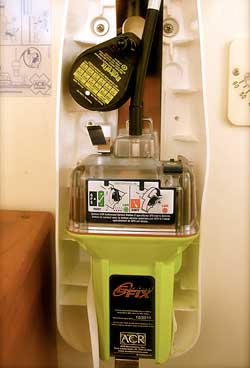
Windtraveler- PLB
We literally have thousands of dollars worth of gear on our boat that we hope we NEVER have to use. It’s crazy, really. EPIRB, life raft and our extreme offshore medical kit just to name a few of the biggies. Not to mention all the flares, fire extinguishers, and life jackets we have as well (as required by the coast guard).
None of this equipment is cheap. In fact, all of this equipment is quite expensive, which is why lots of boaters on a budget forego some of it. We’re in the conservative camp of cruisers. We like to have our bases covered. In our minds, it’s better to be safe than sorry, and we were lucky that we could afford some extra peace of mind with these safety measures. We’ve met lots of boats who are not in our camp for various reasons and some who believe that things like EPIRBs and life rafts are a waste of money—to each his own, as they say.
The other night over drinks with some new friends who just completed an Atlantic crossing, we talked about their uneventful journey and they told one pretty harrowing tale of a crossing that occurred a few years ago that didn’t fare so well. Pretty much the worst thing that can happen on a voyaging boat would be to come up for your watch to find the person who should be on deck, gone. It’s my own personal nightmare, and I know it’s shared by many other cruisers as well.
This is exactly what happened to this particular boat. This story was told to me second-hand so the details are fuzzy, but apparently when the one friend came up for his shift, the other was gone. There was no sign of him but the broken shackle where he had been tethered. The skipper had no idea if his friend went over 10 minutes or three hours prior. For those of you who aren’t familiar with sailing and man-overboard situations, finding a person in the water in any condition is very, very difficult. Add in waves, wind, currents, and pitch-black night and it becomes almost impossible. This friend eventually gave up hope and continued on his trip devastated and alone. Luckily, this particular boat had left on their crossing just before the ARC rally and had a slew of boats coming behind them. Unbeknownst to the skipper, his friend was picked up by another boat and they were reunited in the Caribbean. It should be understood that this is nothing short of a miracle.
Most people would not be so lucky.
I tell this story because it got us talking about man-overboard situations and ways to protect yourself and avoid them. First and foremost, the number-one rule on our boat is: STAY ON IT. While Scott and I have an impressive array of quality safety equipment aboard Rasmus in the event of an emergency, one thing we do not have are personal location beacons (PLB’s).
The Echopilot caught my eye because it acts differently than most other PLBs I’ve seen. This one is attached to AIS so in order for it to work for you, you must be set up with AIS (we have this on Rasmus, and it’s for sure one of the best systems we installed). It works like this: instead of notifying the Coast Guard (which is on land and could take many, many hours to organize a search and rescue—days if you are in the middle of the ocean somewhere) or simply sounding an alarm on the boat, it triggers an AIS alert on your boat and any other AIS-equipped boat in the near vicinity and (thanks to GPS technology) gives the exact position of the person in the water, right there on the chart plotter. There are several advantages to a system like this, first of all – the boat that is most likely to rescue the person who has fallen overboard is the very one they fell off of (assuming there is another person on the boat to pilot it). Also, giving that boat the victim’s exact position doesn’t only greatly expedite rescue, but increases the odds of rescue tremendously (never underestimate the power of currents, wind and waves and their ability to make things disappear on the ocean!). The other advantage is that it will also notify all other boats equipped with AIS within a four-mile radius. There are several other types of personal recovery systems, but this technology is touted as the “wave of the future” in terms of the evolving sophistication personal location beacons. We shall see.
Like I said, we don’t have any system like this on board Rasmus yet, but before we cross an ocean, I’m sure we will spring for something similar to the Echopilot.* When it comes to safety at sea, money spent on safety gear can be replaced. Life cannot.
Love,
Brittany & Scott
*As I mentioned – in order for this system to work for you it assumes a few things: 1) That you have a chart plotter equipped with AIS and 2) That there is someone else on the boat who can maneuver the boat to the victim. Therefore, as stated on their website, this system is not ideal for a solo sailor. For a singlehander, a PLB is probably the best. After not falling off the boat, of course.







